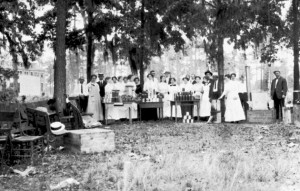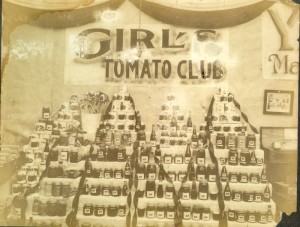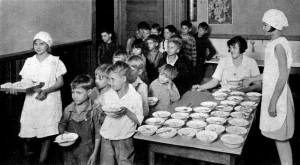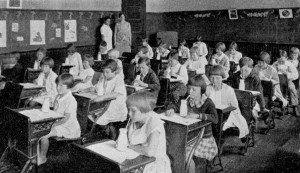The new school year is beginning, and so, inevitably, are jokes about food fights, mystery meat and ketchup-as-a-vegetable. School cafeterias have been a part of public education for such a long time that it’s easy to take them for granted. But what you might not know is that school lunches are the result of a decades-long struggle waged early in the last century to get nutritious food into the nation’s schools. In Florida, home demonstration agents from the Agricultural Extension Service were leaders in the struggle to establish school lunch programs.
Before Cafeterias
Of all the new vocabulary words students encounter when they begin school, the first they learn are probably lavatory, cafeteria, and gymnasium. It’s impossible to imagine, let alone navigate, an elementary school without them. Yet up until the 1940s, many schools in rural Florida were lacking some or all of these vital facilities. Students brought food from home if it was provided, and took their bathroom breaks in outdoor privys or in the same fields where they played during recess. Conditions at home were not likely to be better. As a result, many children in the rural south were malnourished and susceptible to diseases such as anemia and hookworm. A 1930 study of schoolchildren in five Florida counties revealed that 45 percent of children suffered from dental caries, tonsillitis and hookworm, while 30 percent had enlarged lymph glands, conjunctivitis, anemia, or were under-weight. Less than 25 percent of children in the study had adequate diets that included milk, leafy vegetables and fruit. Recognizing this problem, many government, church and civic organizations mobilized to improve health and nutrition in the state’s public schools. One of the most experienced and best prepared of these was Florida Extension’s home demonstration agents.
Wisdom in a Can
The Agricultural Extension Service officially started in Florida in 1915, but years earlier, home demonstration agents had begun giving nutrition and food preparation advice to hundreds of rural families, thanks to the popularity of home canning. In 1909, Agnes Ellen Harris of the Florida State College for Women gave a cooking and food preserving demonstration to women in Ocala. The success of the event led to other “canning parties,” and by 1912, Harris had enrolled more than 500 girls and women in “Tomato Clubs” across the state. In tomato clubs, girls would grow tomatoes on 1/10th of an acre of land, harvest them and preserve them in glass jars or metal cans. Tomato seeds, canning equipment and instruction were provided by Harris’ team of home demonstration agents, women college students or school teachers who worked with the clubs in the summer. They organized regular meetings and field trips, contests within and between clubs for who could can the most tomatoes, and helped club girls make money by selling their canned tomatoes at state fairs and local markets.


It was all meant to be fun, but there was a serious intent behind it. Tomatoes were chosen for club work in part because they were rich in nutrients and easy to grow in home gardens. One of the great ironies of the time was that, while Florida was a rich food-growing state, most of its agricultural population suffered from malnutrition. The fact is that while most rural families worked the land, they either neglected to cultivate a garden for their own tables or didn’t preserve their vegetables, subsisting through the winter on what one agent described as a diet of “fat bacon, collard greens and corn pone.” Harris, who studied nutrition at FSCW and later at Columbia, knew that rural families needed a more varied diet, and hoped that tomato clubs would encourage more households to grow and preserve their own vegetables.
Extension Goes to School
The tomato clubs were a huge success, and when Florida’s Agricultural Extension Service was formed in 1915, its home demonstration agents were already familiar faces in households and schools throughout the state. Recognizing the value of home economics education, the Florida legislature also passed a bill that year authorizing county boards of education to make appropriations for canning and tomato clubs in public schools. With added legitimacy and funding, Harris was able to hire full-time, highly trained agents and begin work on a more ambitious program to improve the lives of Florida’s rural families. At a state meeting in Gainesville in 1916, the new agents gathered to establish a plan of work, with nutrition, infant care, home sanitation and vegetable gardening high on their list of priorities.
By the end of that same year, schools in 30 of Florida’s then-33 counties were working with Extension home demonstration agents, who were setting up canning clubs and nutrition programs in home economics classes.
Working so closely with schools, agents immediately recognized the poor state of school lunches. Students usually brought what was left over from the family’s last meal, so hardboiled eggs, ham hocks or biscuits were common; but milk, fruit or leafy vegetables were rare. It was a short step from teaching nutrition to seeing where it could be improved—right there in the classroom. Agents would keep stressing the importance of eating better at home, but if they could help provide a warm, healthy and satisfying meal at school, the students would carry the message home with them.
A Good Hot Lunch
Many teachers and school boards were concerned about the cost and practicality of cooking hot meals for their students, so in 1917 extension agents in Lee, Duval and Santa Rosa counties devised a plan to teach students to prepare one meal at home and bring it in a jar to school where it would be reheated by boiling. These hot dishes would be supplemented with a bottle of milk and an orange, provided by the school with the help of donations.
The hot dish lunch programs were a success in these counties, and gradually over the next two decades, more and more schools adopted them. As the popularity of the lunch programs caught on, schools began working with home demonstration agents to build kitchens and lunch rooms. In 1920, one high school in Brandon even built a lunch room on school grounds and hired a kitchen manager at $100 per month.
By 1931, 139 schools in 21 counties were working with Extension home demonstration agents and 4-H clubs to serve hot lunches to more than 30,438 school children.

As the school lunch movement grew in Florida, extension agents and 4-H clubs played an increasingly vital role in improving the health of schoolchildren. They developed recipes and menus for more nutritious meals and special programs for underweight or malnourished children; raised funds for kitchen facilities; kept records of students’ weights and heights and assisted health department studies; organized milk and orange juice campaigns to promote drinking healthy beverages; published guidelines for implementing and managing lunch programs; and created posters, booklets, radio shows and films about nutrition, hygiene and the importance of eating a good hot lunch. In many cases, agents also used their influence to establish school gardens, acquire playground equipment, and install sanitary lavatories with indoor plumbing.

The WPA and the National School Lunch Act
School lunch programs began as a grassroots community service, supported through partnerships with local school boards, women’s groups, PTAs, civic and church organizations, growers and businesses. During the depression of the 1930s, that financial support was strained to the point where the federal government had to step in. The Works Progress Administration, a New Deal agency created in 1935, began buying up surplus milk, meat and grain, distributing it to school lunch programs and hiring many unemployed women to staff the lunch rooms. The influx of federal support helped home demonstration agents establish lunch programs at a faster pace, with 241 schools serving hot lunches to 53,000 students by 1941. The WPA dissolved not long after the depression, with unemployment and farm surplus dropping due to World War II.
After the war, another buildup of surplus farm goods led to the National School Lunch Act of 1946, a federal law which subsidizes school lunch programs in all states to this day. Extension nutritionists and home demonstration agents continued to offer support and nutrition education for school lunch programs throughout the 1950s. Beginning in 1963, Extension home economics began expanding its nutritional emphasis to low-income families in Florida’s growing urban areas, and in 1968 it inaugurated the Expanded Nutrition Program, which provides nutritional education to families receiving financial assistance.
Farm to School, School to Farm
Today, the concern in school lunchrooms is not so much malnourishment as childhood obesity and inactivity. Here Extension still plays a big role in bringing nutrition education to Florida’s schools, with programs that help students learn about their food, encouraging them to make healthy food choices and engage in regular physical activity. For example, Youth Understanding MyPlate (YUM) is a curriculum designed by faculty in UF/IFAS’ Department of Family Youth and Community Sciences that introduces children to MyPlate, the USDA’s system for building healthy meals with balanced portions of the major food groups. YUM encourages kids to make informed choices about what they eat though active games, stories, experiments and recipes for healthy snacks.
UF/IFAS Extension also works with the USDA on the Florida Farm to School Program. Farm to School connects schools with area farmers and ranchers to provide fresh, locally grown food for their cafeterias. Schools, in turn, conduct field trips to local farms so that students can learn where their food comes from. Farm to School also provides nutrition education for school curricula, and helps schools plant gardens where they can grow their own food.
With programs like YUM and Farm to School, Extension nutrition education has come full circle, reinventing the school lunch, forming bonds in the local community, and helping kids taste the satisfaction of a good, nutritious meal. It’s something that validates the efforts of hundreds of home demonstration agents from the past 100 years, something that they would recognize and approve of.
Sources:
Ahmann, C.F., O.D. Abbott, G. Westover. 1930. A Nutritional Study of the White School Children in Five Representative Counties of Florida. University of Florida Agricultural Experiment Station, Bulletin 216.
Florida Cooperative Extension. 1916 Annual Report. Gainesville: University of Florida. http://ufdc.ufl.edu/flag/results/brief/?t=extension+annual+report&o=10
___. 1917 Annual Report. Gainesville: University of Florida.
___. 1926 Annual Report. Gainesville: University of Florida.
___. 1930 Annual Report. Gainesville: University of Florida.
___. 1931 Annual Report. Gainesville: University of Florida.
___. 1940 Annual Report. Gainesville: University of Florida.
___. 1943 Annual Report. Gainesville: University of Florida.
Farm to School Partnership. University of Florida Institute of Food and Agricultural Sciences. http://farmtoschool.ifas.ufl.edu
Gunderson, G. W. National School Lunch Program (NSLP). United States Department of Agriculture, Food and Nutrition Service. http://www.fns.usda.gov/nslp/history_4
Minor, K. 2010. “Consumed with a Ghastly Wasting: Home Demonstration Confronts Disease in Rural Florida, 1920-1945.” In Entering the Fray: Gender, Politics and Culture in the New South, edited by J.D. Wells and S.R. Phipps. Columbia, MO: University of Missouri Press.
Stennis, M.A. 1928. Food, Nutrition and Health for School Children. Tallahassee: Agricultural Education Service, Florida State College for Women.
 0
0
